This muffin was filled with strawberry jam, which made it the more edible of our two choices.
Here is Andy drinking some mosh, which is hot sweet milk with oats in it, very popular for breakfast (and tasty).
That night, back in Panajachel, we got some hot chocolate on the street. Very nice, as it gets cold at night in the mountains of Guatemala. Also, it had rice in it, which was fun. From the same street stand, a tostada, which is a crispy corn tortilla, here covered with guacamole, beans, tomato sauce, onions, and cheese.
From the stand down the street, we got some tacos. Check out the huge round taco-cooking aparatus, with different sections for the meat, onions, tortillas, and sauce/grease. The finished product: Messy but tasty.
This coconut jam actually came from Nicaragua, but we busted it open in Guatemala to eat on fresh corn tortillas from the local tortilleria. A tortilleria is a small shop that consists of a griddle and some ladies making about a zillion tortillas a minute on them and selling them really cheap.
Antigua's market brought us into contact with all sorts of new goodies, such as these giant blackberries. Biggest we had ever seen!
Also, blue corn tortillas! When's the last time you ate bread that was naturally this color?
Check out Andy's leisurely pose as he munches on some delicious spicy peanuts from the market. Don't work too hard now, honey.
Here I am on the square in Antigua with booty from my favorite bakery in Guatemala, Dona Luisa Xicotencatl. Amazing banana bread and homemade apple yogurt, among the best yogurts I had on our whole trip. Yum!!
A large coconut candy Andy found in the handicrafts market. Leave it to Andy to find sweets when we were supposed to be shopping for souvenirs...
Some little chicken-filled fried tacos from the market in Antigua. Made healthy by the fresh salad on top, of course.
Ooh, this was bad. It looked good, like a pile of glazed cherries or something, but it turned out to be some kind of gummy crabapples.
Even cheaper than the chocobanana: The chocopapaya! Not quite as good, though.
On to Honduras! We only spent one night there, but we found a great cheap restaurant in Copan called Comedor Mary. Andy got the "plato tipico," which included beef, beans, plantain, grilled veggies, and a little cup of cream. (Honduras and El Salvador are big on cream, for some reason.)
I ordered pupusas, which you can see mostly decimated in the upper righthand corner of the next pic. Pupusas are popular in Honduras as well as El Salvador (kinda like cream!). I got one filled with beans, one with beans and cheese, and one with chayote and cheese. Chayote is a squash kinda like zucchini, and that pupusa was especially amazing.
The pickled cabbage that came with the Honduran pupusas was a lovely purple color thanks to the beets it also contained. And it had chunks of carrot...turns out I love pickled carrot! High marks to this meal from me. On the bus from Honduras up to Flores, our last stop in Guatemala, Andy bought a bag of fried fruit things. There were fried flattened bananas and there were these pineapple-filled doughy things. Way to turn fresh fruit into an unhealthy snack, Guatemala! (Tasty, though.)
Less tasty was this ice cream from the local parlor in Honduras. Bad fakey taste, crumbly texture, and not so cheap. Meh.
Andy found these tasty juice drinks in Flores: Mango-guava and strawberry-banana. At 20% real juice, these may have been the most natural drinks available in all of Central America.
And I finally tried the national brand of yogurt, Gaymont. I liked that the fruit-on-the-bottom cups were clear so you could see what you were getting, and that they came with a handy little spoon (well, I was torn on that, actually--liked the convenience, disliked the extra plastic waste). I did not like the taste, unfortunately...this was no Dona Luisa yogurt!
And that's what we ate in Guatemala and Honduras! Guatemala definitely had the best and cheapest tortillas we had had so far, probably because we were getting really close to Mexico. And oh man, that banana bread...

